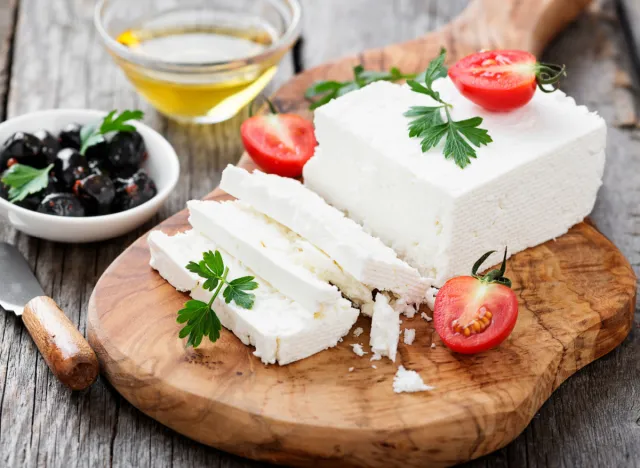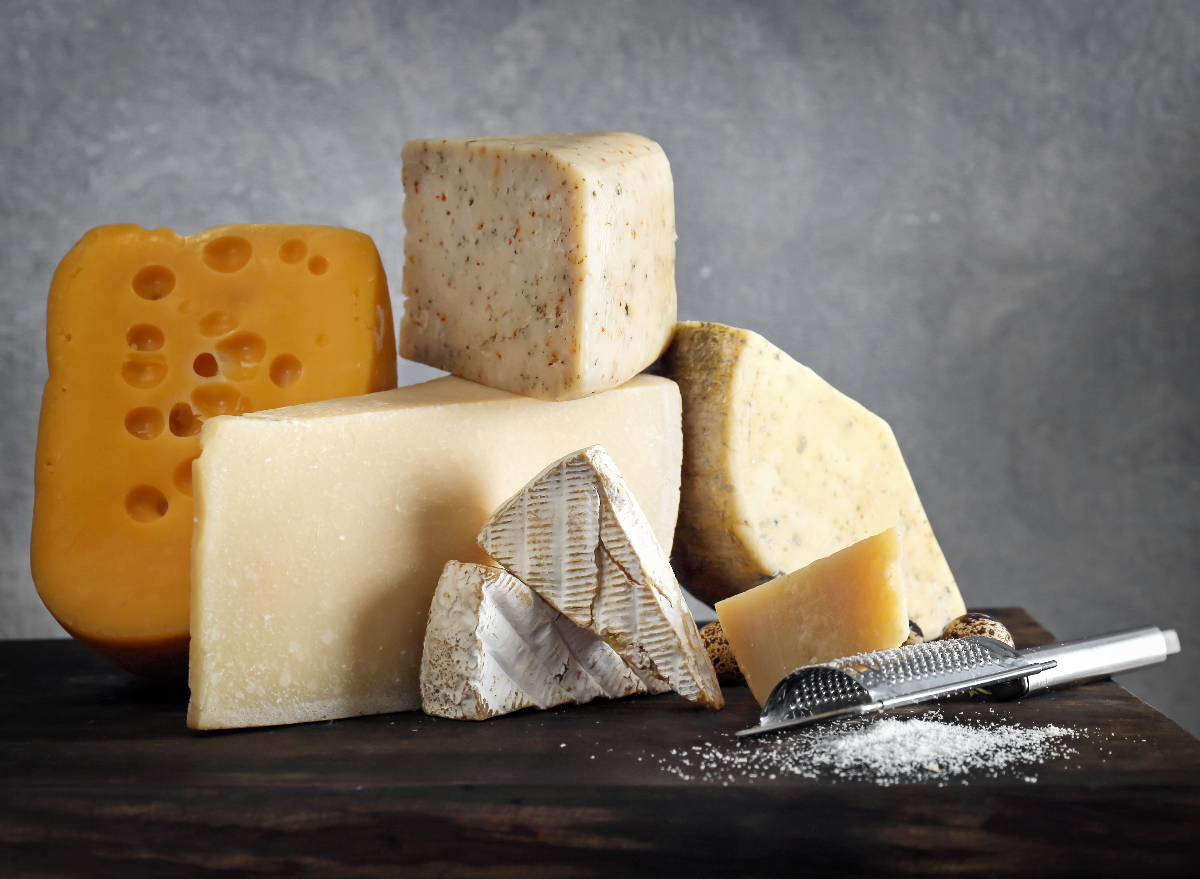Since I grew up in the Midwest, it may come as no surprise that cheese is one of my favorite foods. Americans share this love of cheese, consuming about 42 pounds per person per year, according to Statista. The United States is one of the top cheese-producing countries globally, with Wisconsin, California, and Idaho leading U.S. production.
While many consider cheese a healthy dairy food, some advise against it due to its saturated fat and sodium content. With over 1,500 varieties of cheese, nutritional content can vary significantly. Here’s a closer look at the health benefits of cheese and eight of the healthiest varieties to consider adding to your diet.
Is Cheese Healthy?
Yes, cheese is a nutrient-dense dairy food that can be a valuable part of a healthful diet. Cheese provides high-quality protein, calcium, potassium, magnesium, and B vitamins. Some varieties, particularly those aged but not pasteurized afterward, also contain beneficial probiotics that support digestive and overall health. Common probiotic-rich cheeses include Swiss, Provolone, Gouda, Cheddar, Edam, and cottage cheese, as noted by the Harvard School of Public Health.
However, moderation is key. While cheese has many health benefits, full-fat varieties can be high in saturated fat. The American Heart Association recommends keeping saturated fat to no more than 6% of daily calories—about 13.5 grams for a 2,000-calorie diet. An ounce of Cheddar cheese, for example, contains around 6 grams of saturated fat, so limiting daily intake to about one ounce may be best.
How Much Cheese Should You Eat Per Day?
While there are no strict rules for cheese consumption, a serving a day is a good rule of thumb. A serving typically equals ¼ cup of shredded cheese, one ounce of hard cheese, or ½ cup of cottage cheese. Since cheese can contribute to your daily saturated fat intake, it’s best to balance it with lean proteins and other foods low in saturated fat. When available, choose lower-fat versions of your favorite cheeses to help keep saturated fat levels within recommended limits.
The Healthy Cheese Varieties To Add To Your Diet
- Mozzarella (Part-skim)
- Low-fat (2%) Cottage Cheese
- Feta
- Swiss Cheese
- Parmesan
- Goat
- Ricotta (Part-Skim)
- Aged Cheddar
Here are eight healthiest cheeses to add to your shopping list.
Mozzarella (Part-skim)

Nutrition (Per 1-oz serving):
Calories: 83
Fat: 5.7 g (Saturated Fat: 3.3 g)
Sodium: 196 mg
Carbs: 1.2 g (Fiber: 0 g, Sugar: 0 g)
Protein: 6.6 g
Nearly half of mozzarella‘s weight is water, which helps to make it a best-bet option. Having so much water means that mozzarella has fewer calories, saturated fat, and sodium compared to many other “denser” varieties of cheese. Enjoy as part of your favorite Italian dishes or keep single-serve Mozzarella sticks on hand for a protein-packed snack.
Low-fat (2%) Cottage Cheese

Nutrition (Per ½ cup serving):
Calories: 90
Fat: 2 g (Saturated Fat: 1.3 g)
Sodium: 353 mg
Carbs: 4.5 g (Fiber: 0 g, Sugar: 0 g)
Protein: 12 g
Cottage cheese is one of the highest-protein, lowest-fat cheese varieties, making it a popular so-called “diet” food. It is made by fermenting milk and removing the watery whey, leaving primarily the slow-to-digest casein protein. Since cottage cheese isn’t aged, it has a mild flavor and offers great versatility compared to more flavor-packed aged cheese. In addition to being calcium-rich cottage cheese provides leucine, an essential amino acid for building and retaining muscle mass. Enjoy cottage cheese as a high-protein replacement for ricotta cheese in Italian dishes or blend it into smoothies, pancakes or waffles, or on top of your salads.
Feta

Nutrition (Per 1-oz serving):
Calories: 76
Fat: 5.3 g (Saturated Fat: 3 g)
Sodium: 288 mg
Carbs: 1.6 g (Fiber: 0 g, Sugar: 0 g)
Protein: 5.5 g
Feta is a salty cheese made usually from sheep or goat’s milk. It is packaged in brine, which makes is saltier than most other types of cheese. It makes our list of the top eight healthy cheese varieties for your health because it is lower in calories and saturated fat than most. It also packs a flavorful punch, so a little feta can add a lot of flavor to your foods. Enjoy feta crumbled in salads, blended with scrambled eggs, or sprinkled on roasted veggies to add a flavorful punch.
Swiss Cheese

Nutrition (Per 1-oz serving):
Calories: 76
Fat: 5.3 g (Saturated Fat: 3 g)
Sodium: 288 mg
Carbs: 1.6 g (Fiber: 0 g, Sugar: 0 g)
Protein: 5.5 g
High in protein, Swiss cheese is one of the healthiest cheeses because it contains more vitamin B12 than other cheeses, and it is one of the few cheeses with vitamin A, which is a nutrient important for your immune system and eyes. Interestingly, the holes in Swiss cheese are formed by carbon dioxide during the aging process and the larger the holes in the cheese, the stronger the flavor. Swiss cheese is a great flavor enhancer in salads, as a topper on chili or on top of a lean turkey burger.
Parmesan (Grated)

Nutrition (Per 1-oz serving):
Calories: 117
Fat: 5.3 g (Saturated Fat: 4.3 g)
Sodium: 490 mg
Carbs: 3.4 g (Fiber: 0 g, Sugar: 0 g)
Protein: 8.2 g
This classic Italian hard cheese is usually enjoyed in pasta and other Italian dishes. It is higher in sodium than many other cheeses, but due to its high protein and moderate saturated fat, it makes our best bet list. For individuals who are lactose intolerant, Parmesan is lower in lactose than most other cheeses, so it may be an option in small amounts for those who are sensitive to lactose. Enjoy Parmesan sprinkled on roasted veggies, soups and stews or add it to your pasta dishes. Use freshly grated Parmigiano Reggiano instead of the more processed Parmesan cheese that comes in the tubs.
Goat

Nutrition (Per 1-oz serving):
Calories: 103
Fat: 8.4 g (Saturated Fat: 5.8 g)
Sodium: 118 mg
Carbs: 0 g (Fiber: 0 g, Sugar: 0 g)
Protein: 6.1 g
Goat cheese, aka chevre, has six grams protein and essential nutrients like calcium and vitamin A. It also provides probiotics to promote GI health. Compared to cow’s milk cheese, goat cheese has lower lactose levels, making it gentler on the digestive system and a great choice for those with lactose sensitivities. Enjoy goat cheese crumbled on salads, spread on whole-grain toast, or melted into savory pasta dishes for a creamy, tangy boost of flavor and nutrition.
Ricotta (Part-Skim)

Nutrition (Per 1-oz serving):
Calories: 164
Fat: 2.2 g (Saturated Fat: 1.4 g)
Sodium: 28 mg
Carbs: 1.4 g (Fiber: 0 g, Sugar: 0 g)
Protein: 3.2 g
Ricotta contains a lot of water, which helps keep its calories, fat and sodium lower than many other cheeses. It has more whey protein, the quick-to-digest dairy protein, rather than casein. It is a good source of calcium, vitamin A, B-vitamins and potassium. Mild in flavor, ricotta works well with sweet or savory foods. Spread it on whole grain toast with fresh berries, as a sandwich spread or with your favorite pasta dishes.
Aged Cheddar

Nutrition (Per 1-oz serving):
Calories: 115
Fat: 9.5 g (Saturated Fat: 5.4 g)
Sodium: 180 mg
Carbs: 0 g (Fiber: 0 g, Sugar: 0 g)
Protein: 6.8 g
Sharp or aged cheddar has lower lactose and can be easier on digestion. During the aging process, lactose levels decrease, making aged cheddar easier to digest for those with lactose sensitivity. Additionally, aged cheddar is rich in vitamin K2, an essential vitamin for bone density. It also contains beneficial probiotics, which support GI health and your overall immune system. Enjoy cheddar cheese shredded in your salads, on top of soups and stews or in whole grain salads, or partner with sliced apples or pears.









